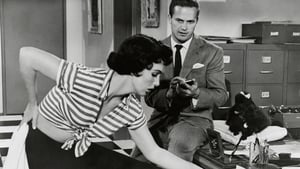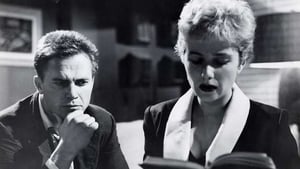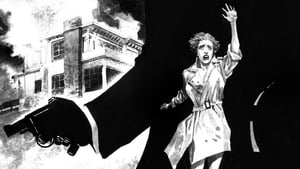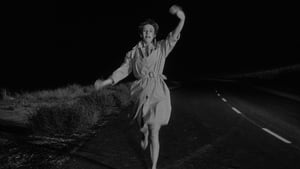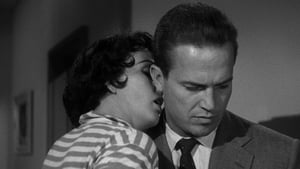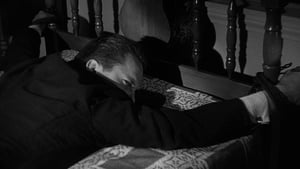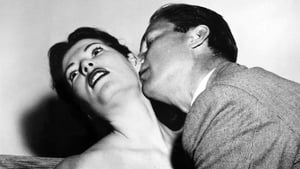Contact: info@alwanfilm.com
Video Sources 0 Views

Synopsis
Reviwing Kiss Me Deadly 1955 Colorized – A Colorized Gem from the Noir Era

Introduction
From the dimly lit alleys to the enigmatic characters, Kiss Me Deadly 1955 epitomizes the essence of film noir. With its intriguing plot and iconic visuals, this classic noir film has captivated audiences for decades. Now, with the release of its early colored version, viewers have the opportunity to experience the film in a whole new light. In this review, we delve into the significance of Kiss Me Deadly 1955’s early colored version and its impact on the cinematic landscape.
Check The Full Colorized Movies List
Check Our Colorized Movies Trailer Channel
Understanding Kiss Me Deadly 1955 Colorized Director, Cast, and Genre
Directed by Robert Aldrich, Kiss Me Deadly 1955 boasts a stellar cast including Ralph Meeker, Albert Dekker, and Maxine Cooper. Aldrich’s vision for the film was to push the boundaries of the noir genre, resulting in a gritty and suspenseful cinematic masterpiece. The film is a quintessential example of film noir, characterized by its dark themes, morally ambiguous characters, and atmospheric visuals. Aldrich’s direction and the performances of the cast contribute to the film’s enduring legacy as a classic of the genre.
Exploring the World of Kiss Me Deadly 1955 Colorized: Plot and Characters
Set against the backdrop of post-war Los Angeles, Kiss Me Deadly 1955 follows private investigator Mike Hammer as he delves into a web of deception and danger. The film’s plot is rife with twists and turns, keeping viewers on the edge of their seats until the very end. From the enigmatic Christina Bailey to the menacing Dr. Soberin, each character adds depth and intrigue to the story. The plot unfolds in a series of unpredictable events, leading to a shocking and unforgettable conclusion that has left audiences captivated for generations.
The Art of Film Colorization
Film colorization is a technique used to add color to black and white films, breathing new life into classic movies. While purists may argue against colorization, it offers a fresh perspective on beloved films, allowing viewers to experience them in a different light. The process of colorization involves digitally adding color to each frame of the original black and white film, carefully selecting hues and tones to recreate the look and feel of the original scenes. When done effectively, colorization can enhance the visual appeal of a film and introduce it to new audiences who may be more accustomed to color cinema.
Early Colored Films: A Brief History
The practice of colorizing films dates back to the early days of cinema, with studios experimenting with various techniques to add color to black and white films. In the early 20th century, hand-tinting was commonly used to add color to silent films, with artists meticulously painting each frame to achieve the desired effect. As technology advanced, colorization techniques became more sophisticated, allowing for the creation of vibrant and lifelike colors in black and white films. Today, digital colorization has become the standard method for adding color to classic films, with advanced software and techniques making it possible to achieve stunning results.
Kiss Me Deadly 1955 and Its Early Colored Version
The decision to release Kiss Me Deadly 1955 in a colorized format was met with both excitement and skepticism. While some welcomed the opportunity to see the film in color, others questioned the need to tamper with a classic. However, the early colored version of Kiss Me Deadly 1955 offers a fresh perspective on the film’s iconic visuals, adding new depth and dimension to the viewing experience. By carefully selecting colors that complement the film’s noir aesthetic, the colorized version preserves the mood and atmosphere of the original while introducing it to a new generation of viewers.
The Debate Over Film Colorization
The debate over film colorization remains contentious, with supporters praising its ability to breathe new life into classic films, while detractors argue that it detracts from the original artistic vision. Proponents of colorization argue that it can make older films more accessible to modern audiences, who may be less inclined to watch black and white films. They also point out that colorization can enhance the visual appeal of a film and make it more immersive for viewers. However, opponents argue that colorization can alter the intended look and feel of a film, robbing it of its original charm and authenticity. They also contend that colorization can be a form of revisionism, altering the historical record and disrespecting the legacy of filmmakers who created their works in black and white.
Examining Kiss Me Deadly 1955 as an Early Colored Film
In analyzing Kiss Me Deadly 1955 as an early colored film, it’s essential to consider how colorization enhances or detracts from the viewing experience. While the addition of color may offer a fresh perspective on the film’s visuals, it’s crucial to preserve the integrity of the original black and white version. In the case of Kiss Me Deadly 1955, the early colored version succeeds in enhancing the film’s noir aesthetic, adding depth and dimension to the dark and atmospheric visuals. By carefully selecting colors that complement the film’s tone and mood, the colorized version preserves the integrity of the original while introducing it to new audiences.
Influence and Legacy: Kiss Me Deadly 1955 Colorized’s Impact on Cinema
Kiss Me Deadly 1955 has left an indelible mark on the cinematic landscape, influencing countless filmmakers and inspiring generations of cinephiles. Its early colored version serves as a testament to the enduring legacy of film noir and the timeless appeal of classic cinema. By embracing colorization, Kiss Me Deadly 1955 continues to captivate audiences with its gripping narrative and unforgettable characters, ensuring its place in the pantheon of cinematic classics for years to come.
Director’s Cinematic Legacy: Beyond Kiss Me Deadly 1955 Colorized
Robert Aldrich’s influence extends far beyond Kiss Me Deadly 1955, with the director leaving an indelible mark on the world of cinema. His bold vision and uncompromising approach to filmmaking have cemented his status as one of the most iconic directors of the noir era. Aldrich’s legacy lives on in the countless filmmakers who have been inspired by his work, ensuring that his contributions to cinema will never be forgotten.
Themes Explored in Kiss Me Deadly 1955 Colorized
From its exploration of corruption and greed to its commentary on post-war society, Kiss Me Deadly 1955 delves into a myriad of dark and thought-provoking themes. Its timeless appeal lies in its ability to resonate with audiences of all generations, offering a searing indictment of the human condition that remains as relevant today as it was upon its original release. The film’s exploration of moral ambiguity and existential despair continues to fascinate viewers, inviting them to ponder the deeper meaning behind its enigmatic narrative.
Reception and Controversy Surrounding Kiss Me Deadly 1955 Colorized
Upon its release, Kiss Me Deadly 1955 received critical acclaim for its innovative storytelling and atmospheric visuals. However, its early colored version sparked controversy among fans and critics alike, with opinions divided on the merits of colorization. While some praised the colorized version for breathing new life into the film, others argued that it detracted from the original black and white version. Despite the debate, Kiss Me Deadly 1955 remains a beloved classic of the noir genre, cherished by cinephiles for its timeless appeal and enduring legacy.
Where to Watch Kiss Me Deadly 1955 Colorized Online
For those eager to experience Kiss Me Deadly 1955 in its early colored version, the film is available on popular streaming platforms, offering viewers the opportunity to immerse themselves in the world of film noir from the comfort of their own homes. Whether seen in its original black and white format or in vibrant color, Kiss Me Deadly 1955 continues to captivate audiences with its gripping narrative and unforgettable characters, ensuring its place in the pantheon of cinematic classics for years to come.
FAQs About Kiss Me Deadly 1955 Colorized
Q: Is Kiss Me Deadly 1955 based on a true story?
A: Kiss Me Deadly 1955 is a work of fiction, although it draws inspiration from real-life events and historical figures. Director Robert Aldrich crafted a gripping narrative that captures the essence of film noir, blending elements of mystery, suspense, and intrigue to create a cinematic experience unlike any other.
Q: What makes Kiss Me Deadly 1955 stand out from other film noir classics?
A: Kiss Me Deadly 1955 distinguishes itself through its bold visuals, innovative storytelling, and memorable characters. Director Robert Aldrich pushed the boundaries of the noir genre, creating a film that is as thrilling as it is thought-provoking. From its iconic opening sequence to its shocking conclusion, Kiss Me Deadly 1955 is a cinematic tour de force that continues to captivate audiences to this day.
Q: Does the early colored version of Kiss Me Deadly 1955 enhance the viewing experience?
A: While purists may prefer the original black and white version, the early colored version of Kiss Me Deadly 1955 offers a fresh perspective on the film’s visuals, adding new depth and dimension to the viewing experience. By carefully selecting colors that complement the film’s noir aesthetic, the colorized version preserves the mood and atmosphere of the original while introducing it to a new generation of viewers.
Q: What was the critical reception of Kiss Me Deadly 1955 upon its release?
A: Kiss Me Deadly 1955 received critical acclaim for its bold visuals, innovative storytelling, and memorable performances. However, its early colored version sparked controversy among fans and critics alike, with opinions divided on the merits of colorization. While some praised the colorized version for breathing new life into the film, others argued that it detracted from the original black and white version.
Q: Who was involved in the production of Kiss Me Deadly 1955?
A: Kiss Me Deadly 1955 was directed by Robert Aldrich, who brought his unique vision and style to the film. The cast included Ralph Meeker as the enigmatic private investigator Mike Hammer, Albert Dekker as the sinister Dr. Soberin, and Maxine Cooper as the mysterious Christina Bailey. Together, they brought Aldrich’s vision to life, creating a cinematic masterpiece that continues to captivate audiences to this day.
Conclusion
In conclusion, Kiss Me Deadly 1955 remains a timeless classic of the film noir genre, beloved by cinephiles around the world. Its early colored version offers a fresh perspective on the film’s iconic visuals, adding new depth and dimension to the viewing experience. Whether seen in its original black and white format or in vibrant color, Kiss Me Deadly 1955 continues to captivate audiences with its gripping narrative and unforgettable characters. As a testament to the enduring legacy of film noir, Kiss Me Deadly 1955 remains a cinematic masterpiece that will continue to be celebrated for generations to come.
